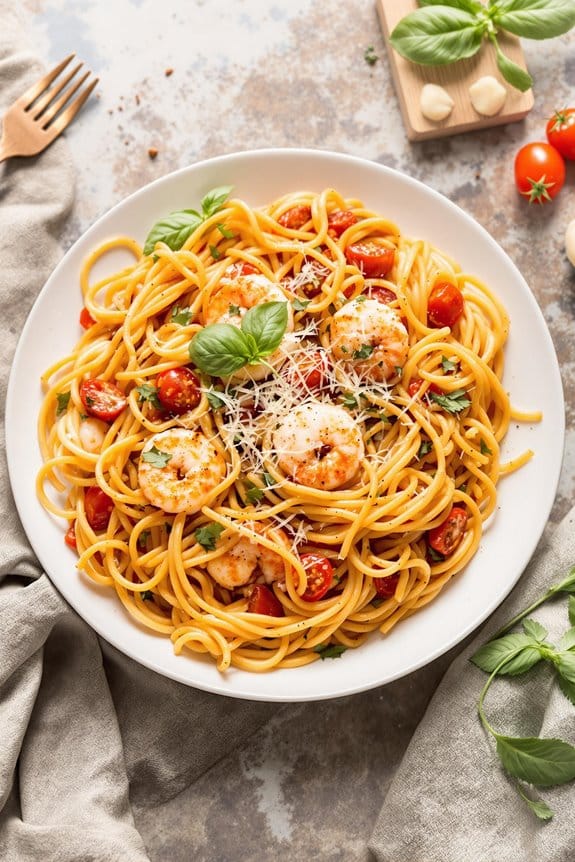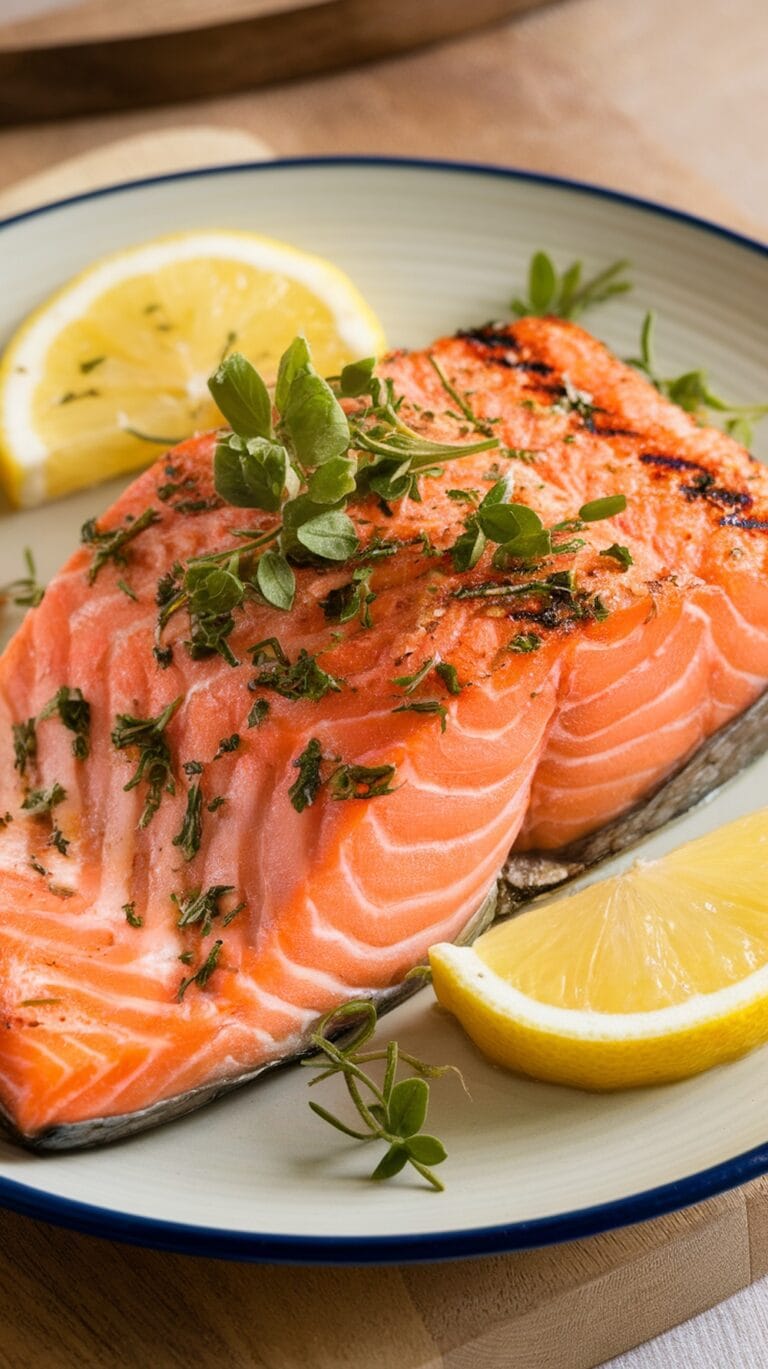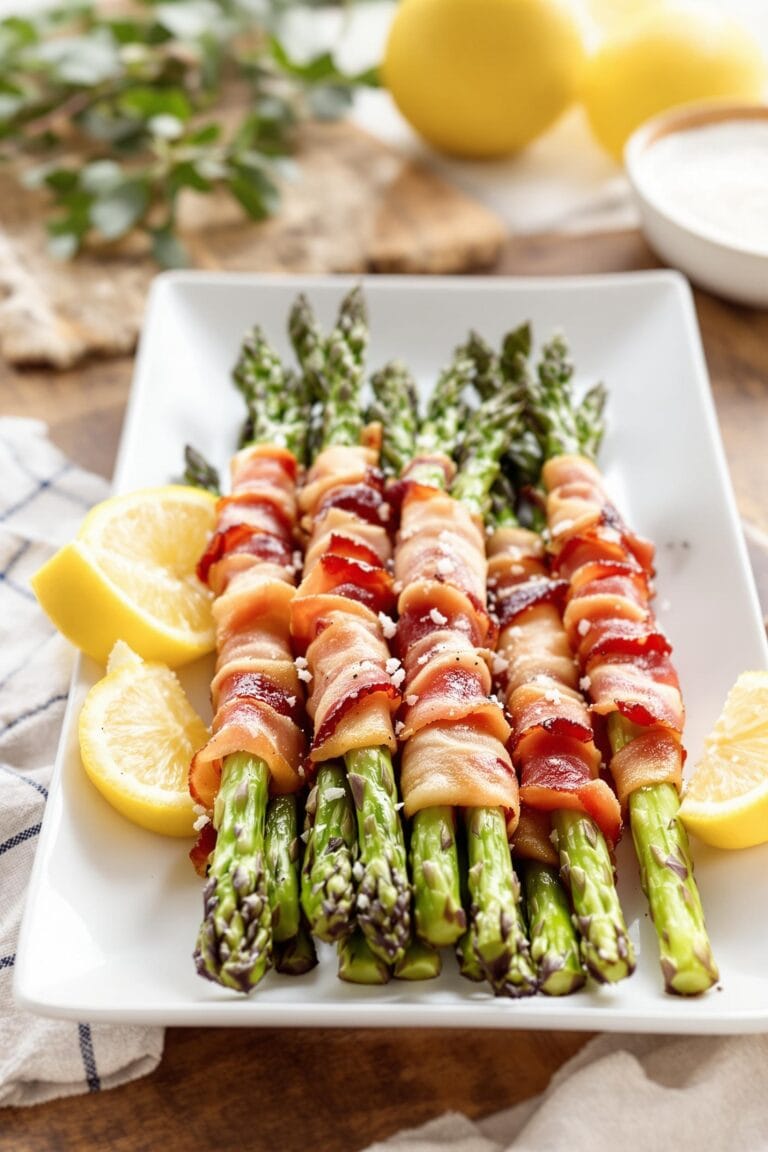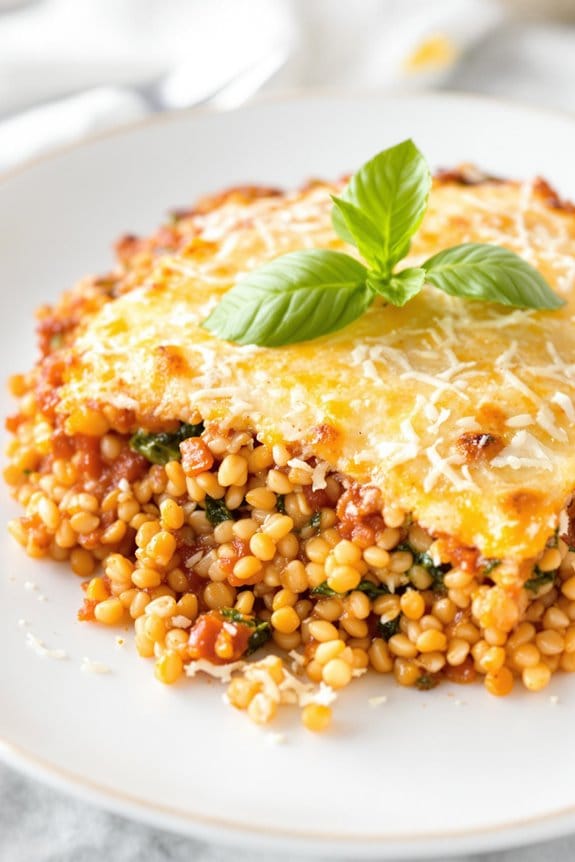Have you ever tried making Spicy Shrimp Arrabbiata Pasta in your own kitchen? It’s a dish where the spicy heat of the arrabbiata sauce blends perfectly with the succulence of shrimp, providing a delightful juxtaposition of flavors that could liven up your typical dinner rotation. While the traditional recipe hails from Lazio, many chefs add personal twists to enhance the dish’s complexity and appeal. Consider, for instance, the choice of herbs or the type of shrimp you use—each element can drastically alter the final taste. But there’s a particular technique that might just transform your approach to this classic—care to venture a guess?
History
Arrabbiata sauce, with its roots in the Lazio region of Italy, particularly Rome, has long brought fiery flavor to traditional Italian cuisine. Its name, derived from the Italian word *arrabbiato*, means “angry,” and aptly describes the sauce’s spicy kick from red chili peppers.
You’d be intrigued to learn that arrabbiata sauce became popular in the mid-20th century, though its exact origins are shrouded in the delightful mysteries of Italian kitchens.
The sauce’s bold personality and minimalistic approach, primarily using garlic, tomatoes, and chili, reflect the local appreciation for vivid, unadulterated flavors that can transform a simple meal into a spirited affair.
It’s not just a sauce; it’s a reflection of the robust and spirited heart of Roman culinary tradition.
Recipe
Spicy Shrimp Arrabbiata Pasta offers an enticing blend of fiery spices and succulent shrimp tossed with al dente pasta, all cloaked in a rich, garlicky tomato sauce. This Italian-inspired dish is a perfect choice for those who enjoy a little heat in their meal. Arrabbiata, meaning “angry” in Italian, refers to the intensity of the spices used in this sauce, and when paired with the delicate sweetness of shrimp, the contrast is absolutely delightful.
Preparing this dish can be a quick evening affair, ideal for a busy weeknight yet impressive enough for entertaining guests. The key to mastering this dish is in balancing the richness of the tomatoes with the heat from the chili peppers and the natural flavors of the shrimp. Timing is essential, as you want to guarantee that the shrimp are cooked just right, tender and juicy, without being overdone.
Ingredients:
- 1 lb of large shrimp, peeled and deveined
- 12 oz spaghetti or any long pasta
- 1 can (14 oz) of crushed tomatoes
- 3 cloves garlic, minced
- 1 red chili pepper, finely chopped (adjust based on heat preference)
- 1/2 teaspoon red pepper flakes (optional for extra heat)
- 1/4 cup olive oil
- 1/2 cup fresh basil, chopped
- Salt and pepper to taste
- Grated Parmesan cheese (for serving)
- Fresh parsley, chopped (for garnish)
In a large pan, heat the olive oil over medium heat and sauté the garlic and chili pepper until they become fragrant, about 1 minute. Add the crushed tomatoes and red pepper flakes if using; simmer the sauce on low heat for 15 minutes to blend the flavors together.
While the sauce simmers, cook the pasta in a separate pot according to package instructions until al dente. Add the shrimp to the sauce, cooking just until they turn pink and are cooked through, approximately 3-5 minutes. Drain the pasta and toss it with the shrimp arrabbiata sauce. Garnish with fresh basil, parsley, and a sprinkle of Parmesan cheese.
For an ideal cooking experience, make sure not to overcrowd the pan when sautéing the shrimp; this allows them to cook evenly and remain tender. Adjusting the amount of chili can tailor the heat level to your liking, making the dish more or less “angry”.
Serving this pasta with a side of crusty bread is wonderful for soaking up the flavorful sauce, and a light salad can balance the meal beautifully. Don’t skimp on fresh herbs as they add a fresh, vibrant layer to the dish. Enjoy your fiery, flavor-packed Spicy Shrimp Arrabbiata Pasta!
Step 1. Prepare Shrimp and Ingredients
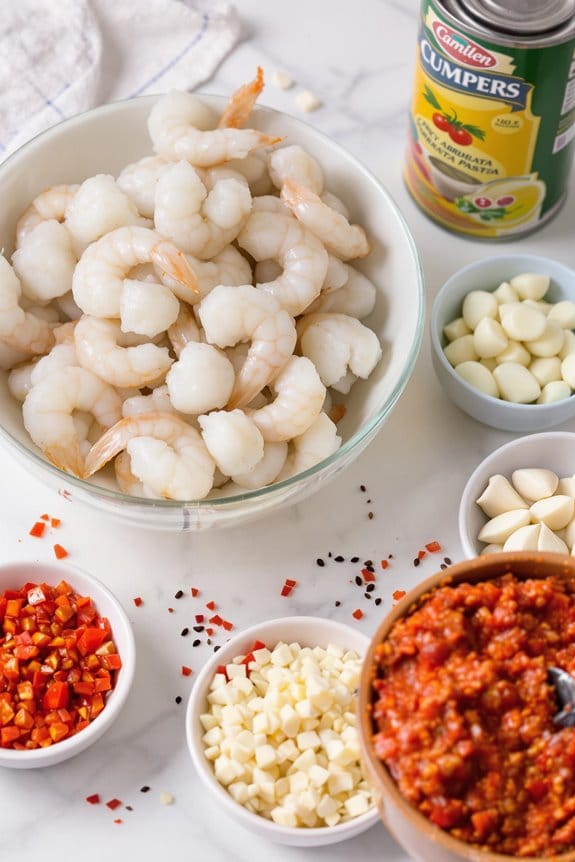
Before you begin cooking, gather all the necessary ingredients for your spicy shrimp arrabbiata pasta.
You’ll need fresh or frozen shrimp, peeled and deveined, ensuring they’re thoroughly cleaned.
Grab ripe tomatoes, preferably plum, as they’re less watery, and crush them for the sauce.
You’ll also require fresh basil and parsley, finely chopped, along with a pinch of chili flakes to adjust the spice level to your preference.
Secure a pack of your favorite pasta, be it spaghetti or linguine.
Don’t forget to have olive oil on hand, and check your pantry for basic spices like salt and black pepper to taste.
Preparing these ingredients before the actual cooking begins makes the process smoother and quicker.
[DIRECTIONS]:
Step 2. Sauté Garlic and Onions
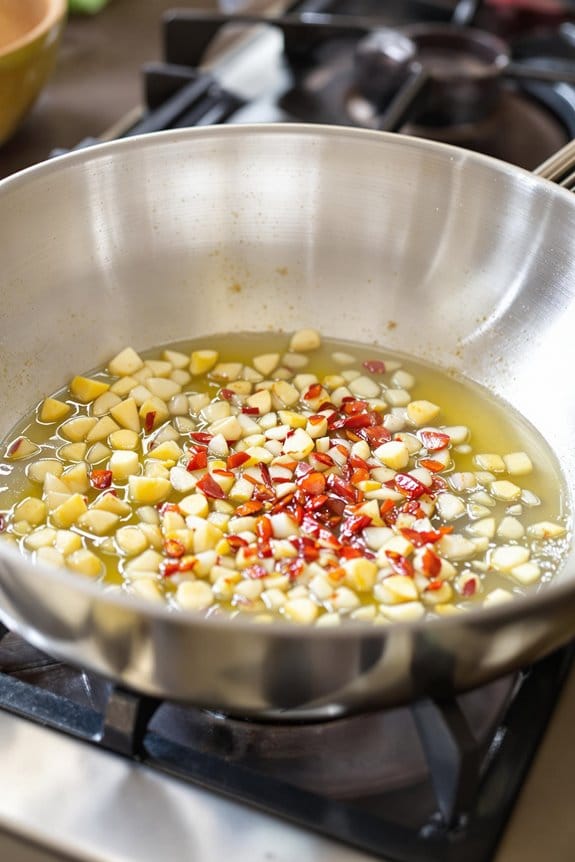
Now that you’ve prepped your ingredients, it’s time to build the aromatic base for your pasta sauce. Start by heating a generous drizzle of olive oil in a large skillet over medium heat.
Once it’s warm, add your chopped onions, stirring until they’re just translucent—this usually takes about 2 to 3 minutes.
Next, toss in the minced garlic, being careful not to let it burn. You’ll want to stir continuously for about a minute until the garlic is fragrant and golden.
This sautéing process is essential; it releases the flavors that are key to the depth of your arrabbiata sauce. Make sure the heat isn’t too high, as you don’t want to scorch the garlic, which can introduce bitterness.
Step 3. Add Tomato Sauce Mixture
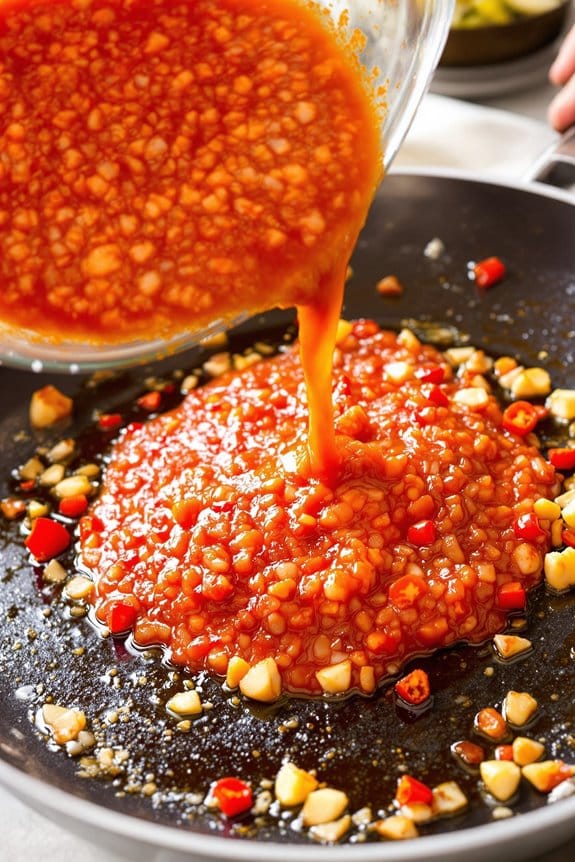
After sautéing the garlic and onions, add the tomato sauce to the skillet.
Pour it in slowly, allowing it to blend seamlessly with the fragrant base you’ve created.
As the sauce simmers, stir it gently to combine the flavors.
Pay attention to the consistency; it should be thick enough to cling to the pasta but fluid enough to allow for easy stirring.
Give the sauce time to cook down a bit, typically about 10 minutes, as this enhances the depth and richness of the taste.
Step 4. Incorporate Spices and Shrimp
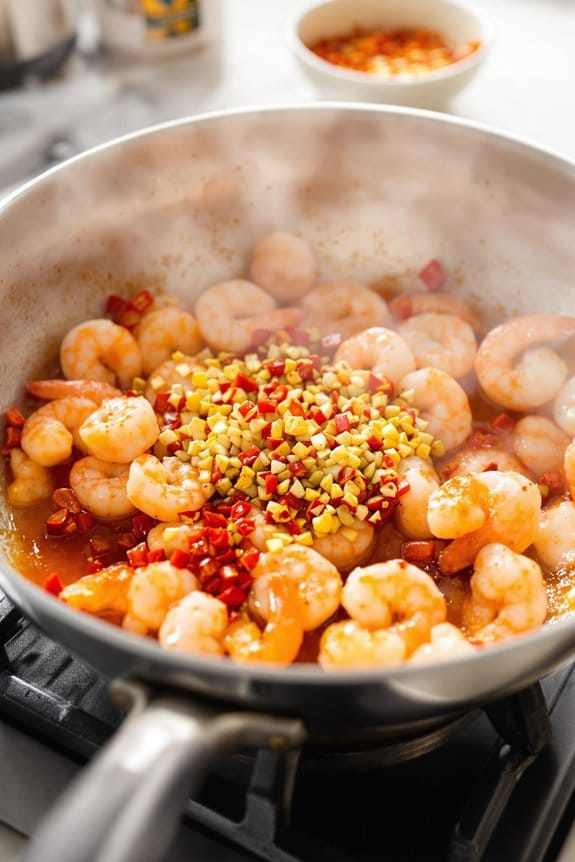
With the tomato sauce simmering to a perfect consistency, it’s time to add a kick of heat and the star ingredient: the shrimp.
First, sprinkle in your chosen spices—this could be anything from classic crushed red pepper flakes to a more adventurous mix like smoked paprika or cayenne pepper. Stir these well into the sauce to guarantee even distribution and let the flavors meld for a minute or two.
Next, gently lay the shrimp into the sauce. Make sure they’re spaced out so they can cook evenly. Remember, shrimp cook quickly, so keep an eye on them!
Here are some quick tips to make sure you get it just right:
- Season generously: Don’t skimp on the spices!
- Stir gently: Keep the shrimp intact.
- Even distribution: Spread the shrimp evenly.
- Watch closely: Shrimp cook in just a few minutes.
- Taste as you go: Adjust spices as needed for perfect flavor.
Step 5. Simmer Pasta With Sauce
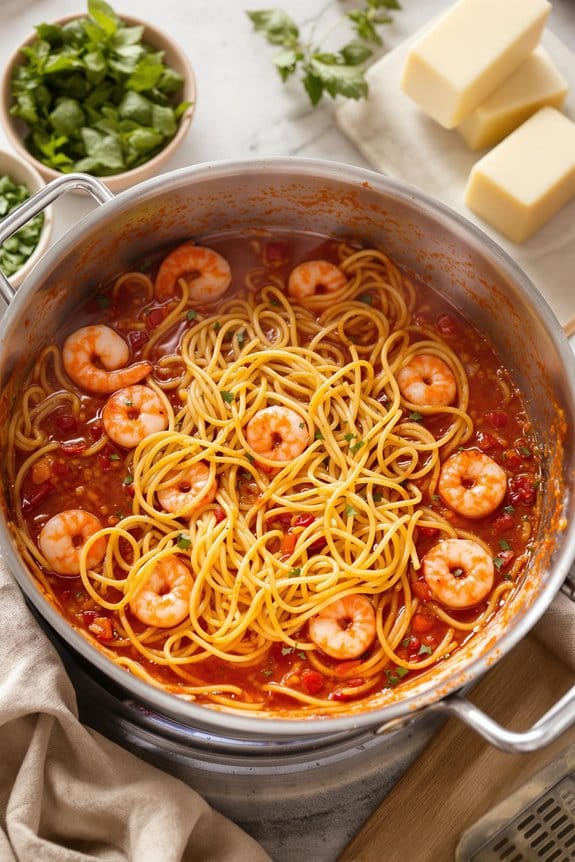
Once the shrimp are pink and cooked through, it’s time to combine them with the pasta.
Drain your pasta and toss it into the skillet with the sautéed shrimp. Pour the arrabbiata sauce over the shrimp and pasta.
Give it a good stir to make sure everything’s well-coated with the spicy sauce. Once mixed, let the pasta simmer for about 5 minutes. This will help the flavors meld together beautifully.
The heat should be just enough to keep the mixture bubbling gently. Be sure to stir occasionally to prevent the pasta from sticking to the skillet.
After simmering, the sauce will have thickened slightly, clinging perfectly to each strand and morsel, enveloping them in its spicy, aromatic embrace.
Enjoy your masterpiece hot.
New Recipe
- Pepperoni and Hot Honey PizzaTry the tantalizing twist of pepperoni pizza with hot honey, where sweet meets heat—how will it transform your taste buds?
Cooking Tips
To elevate your Spicy Shrimp Arrabbiata Pasta, mastering a few key cooking techniques is essential. Here are some practical tips to guarantee your dish bursts with flavor:
- Use fresh shrimp: Opt for fresh, not frozen, shrimp for the best texture and taste.
- Simmer the sauce gently: Let the arrabbiata sauce simmer slowly to develop depth of flavor.
- Salt pasta water: Always salt your pasta water to enhance the pasta’s flavor.
- Don’t overcook the shrimp: Shrimp cook quickly; remove them as soon as they turn pink to avoid toughness.
- Garnish wisely: A sprinkle of fresh basil or parsley can add a revitalizing contrast to the heat of the sauce.
Final Thoughts
After mastering these cooking tips, you’re well on your way to creating a mouthwatering Spicy Shrimp Arrabbiata Pasta.
This dish isn’t just a meal; it’s a delightful journey through spicy, savory flavors paired perfectly with succulent shrimp.
Remember, the key is in the freshness of your ingredients and the balance of spices.
Don’t shy away from adjusting the heat to suit your taste.
As you’ve learned, cooking pasta al dente and sautéing shrimp to just the right texture make all the difference.
Serve this dish with a sprinkle of fresh parsley and a zest of lemon for that extra touch.
You’re not just serving dinner; you’re crafting an experience.
Enjoy the process and the inevitable compliments!

